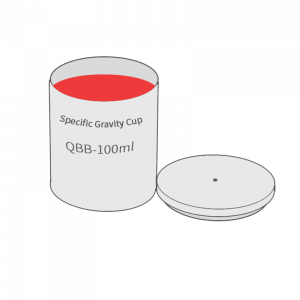Як виміряти щільність лаку за допомогою пляшки питомої ваги
Покриття та лаки є незамінними матеріалами в різноманітних сферах застосування, and their density is one of the important parameters to evaluate their quality and performance. This article will explain how to measure the density of paints and varnishes using a pycnometer, including the scope of application, the required instruments and materials, and detailed measurement steps.
1. Область застосування та опис
Density refers to the mass per unit volume of liquid at a specified temperature, usually expressed in g/ml. This method is suitable for determining the density of liquid coatings, varnishes and other products at specified temperatures. The principle is to use the density of distilled water to calibrate the volume of the specific gravity bottle, and then weigh the mass of the sample through the specific gravity bottle at a certain temperature, so as to calculate the density of the sample.
2. Інструменти та матеріали
Specific gravity bottles: usually available in different capacities, such as 37ml, 50ml and 100ml, made of stainless steel or aluminum alloy.
Thermometer: Accuracy to 0.2 ° C, зазвичай 0.1 ° C.
Constant temperature water bath or constant greenhouse: it is required to be able to maintain within ±0.5 ° C of the test temperature, or higher accuracy is required to be within the range of ±0.2 ° C.
Analytical balance: Accuracy to 0.2mg.

Як виміряти щільність лаку за допомогою пляшки питомої ваги
3. Метод визначення
Calibration of pycnometer:
Use a clean, dry pycnometer and weigh it at room temperature.
The bottle is cleaned, dried and weighed continuously until the difference between the two successive weights does not exceed 0.5mg.
At the test temperature (usually 23±2 ° C, or 23±0.5 ° C for higher accuracy), fill the pyretic flask with distilled water to ensure that there are no bubbles.
Place the pycnometer in a constant temperature water bath or a constant greenhouse until the temperature is constant. Під час цього процесу, make sure that there are no residual water droplets on the outside of the pycnometer.
Immediately weigh a pyretic flask filled with distilled water, accurate to 0.001%.
Як виміряти щільність лаку за допомогою пляшки питомої ваги
Calculation of the volume of the specific gravity bottle:
Use the following formula to calculate the volume of the pycnometer (expressed in ml) :
V = (m1 – m0)/В
Серед них:
V is the volume (мл) of the pycnometer.
m1 is the mass (g) of a pycnometer filled with distilled water.
m0 is the mass (g) of the dry specific gravity bottle.
p is the density of distilled water (зазвичай 1 g/ml).
Як виміряти щільність лаку за допомогою пляшки питомої ваги
Measurement of product density:
Repeat the procedure with the sample instead of the distilled water.
Під час експлуатації, wear analytical gloves to avoid direct contact with the pycnometer.
Care should be taken to avoid bubbles when injecting samples into the pyretic bottle and to ensure that the outside of the pyretic bottle is clean to ensure accurate weighing.
4. Презентація результатів
Calculate the density of the product at the test temperature T (зазвичай 23 ° C or other agreed temperature), expressed in g/ml, according to the following formula:
Density = mass of sample/volume of sample
Як виміряти щільність лаку за допомогою пляшки питомої ваги
5. Висновок
Measuring the density of paints and varnishes is an important step in ensuring their quality and performance. By using a specific gravity bottle and appropriate instruments, the density of the product can be accurately measured, thus helping manufacturers and users to assess its suitability and quality. Density data is very important for production control and quality control, so the correct measurement method and instrument selection is crucial. Through density measurements, the physical properties of paints and varnishes can be better understood to support their applications.
